Astro Session - November 10, 2018
Soulful Friday--more importantly it was a cloudless Friday on the 10th. I'm going to have to do a mosaic for the whole thing, but for now here's the southern end of IC 1848, the "Soul Nebula" in Ha and OIII (Soul is also identified as Westerhout 5 and Sh 2-199). IC 1848 is in the constellation Cassiopeia, and what you see here is a bit more than half the 100 lightyears in length of the whole nebula--so what is that, something like 588 quadrillion miles from top to bottom? At 6,500 light-years away, that will make a nice four panel mosaic. (Notes: 40 x 240 seconds in Ha, 28 x 600 sec. in OIII. Atik 414EX mono CCD, Astronomik 12nm Ha, OIII filters, William Optics ZS61 + WO Flat F6A f/4.7, iOptron CEM25P EQ mount, Orion OAG + ZWO ASI120MM-Mini guide cam, Stellarmate OS (INDI/KStars/Ekos) running on Raspberry Pi 3b+)
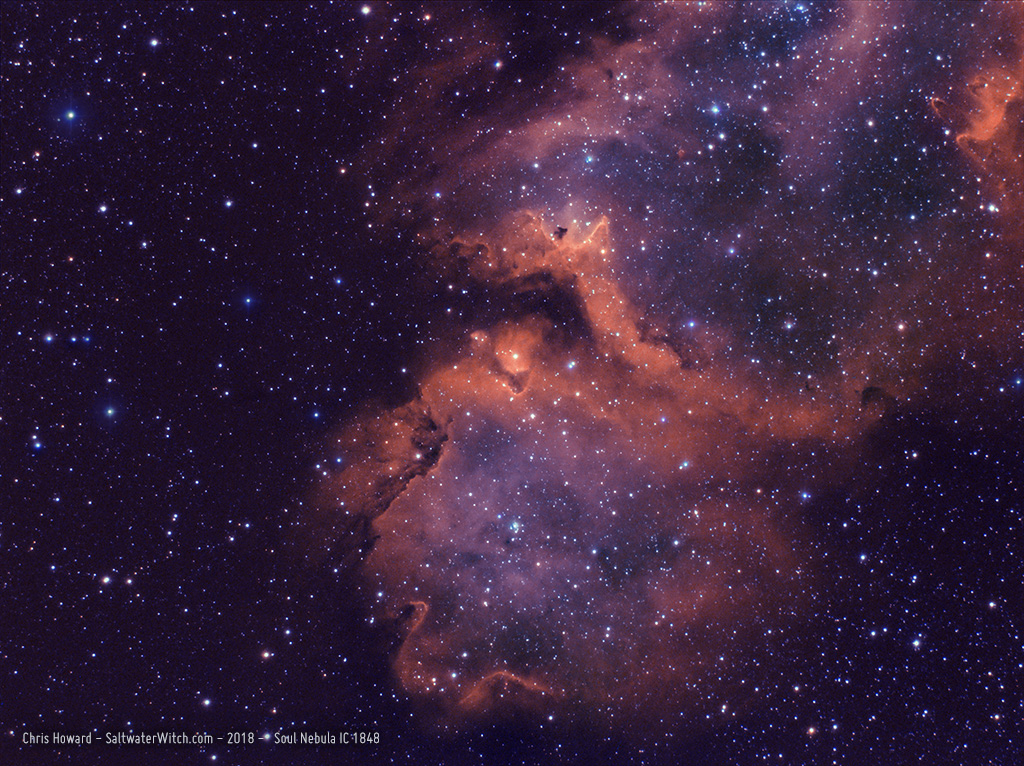
This is the first time I've captured any subs of NGC 2264, the Cone Nebula, about 2600 light-years away (800 Parsecs) in the constellation Monoceros. NGC 2264 includes several identified objects, including the Cone Nebula, Fox Fur Nebula and a massive variable star system, the Christmas Tree Cluster at its core. (Notes: 61 x 300 seconds in Ha, 48 x 300 sec. in OIII. Atik 414EX mono CCD, Astronomik 12nm Ha, OIII filters, William Optics ZS61 + WO Flat F6A f/4.7, CEM25P EQ mount, Orion OAG + ZWO ASI120MM-Mini guide cam, Stellarmate OS (INDI/KStars/Ekos) running on Raspberry Pi 3b+)
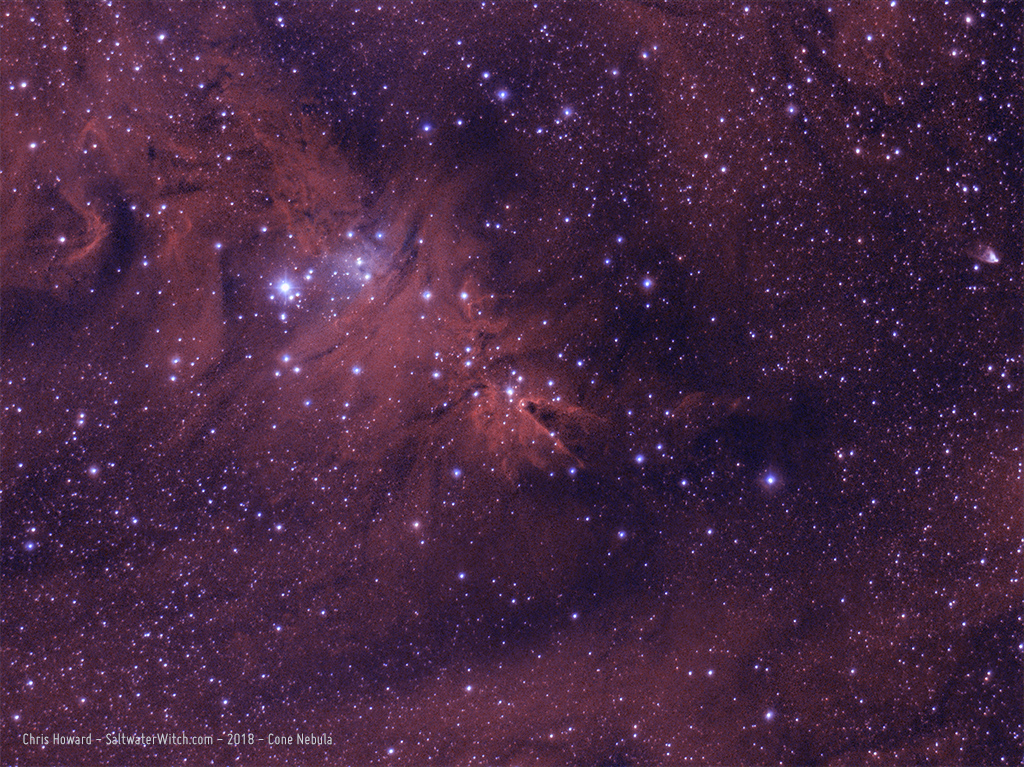
Near-Infrared: I also captured 40 frames of M78, a reflection nebula in the constellation Orion. I captured 20 of each in Ha (~656nm) and infrared with the 685nm longpass filter to see what showed up, and was surprised by what I could see in the unstretched subs. There really is a lot going on at the red end of the spectrum--and beyond, and I combined both of them in this shot, divided evenly across RGB (R=Ha, G=50%Ha/50%IR, B=IR). The plan is to come back with a set of color frames and see if I can combine the whole set.
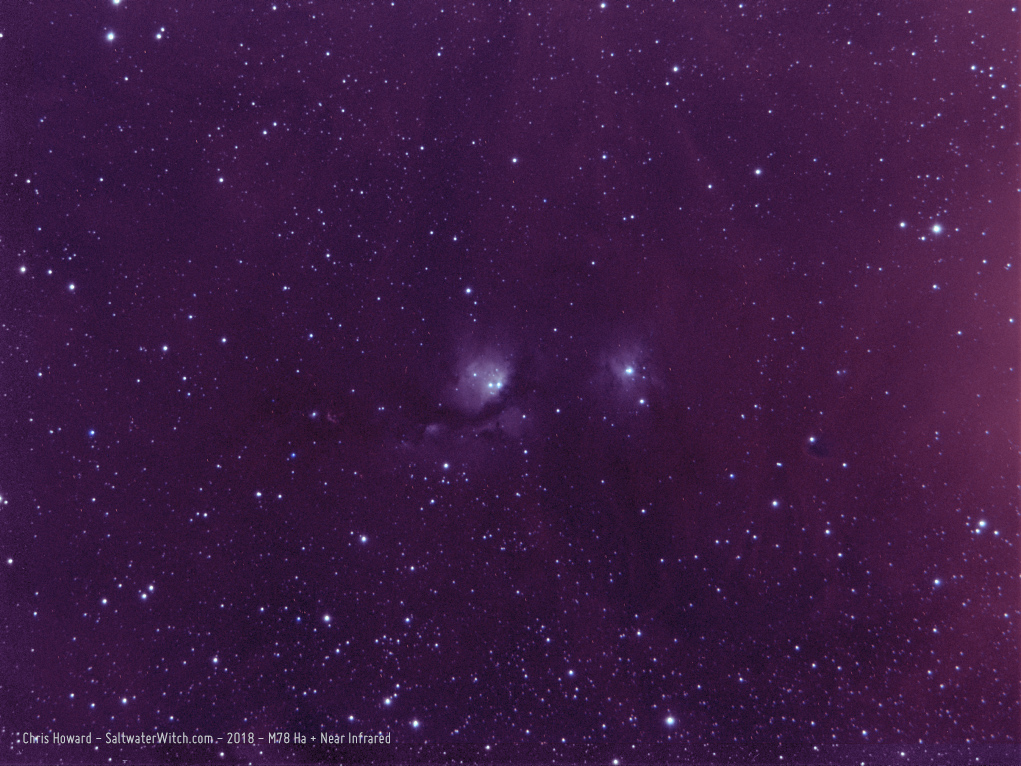
I took some pics of my narrowband setup for this imaging run, before nightfall and in the middle of shooting frames for the Cone Nebula just before Meridian Flip.
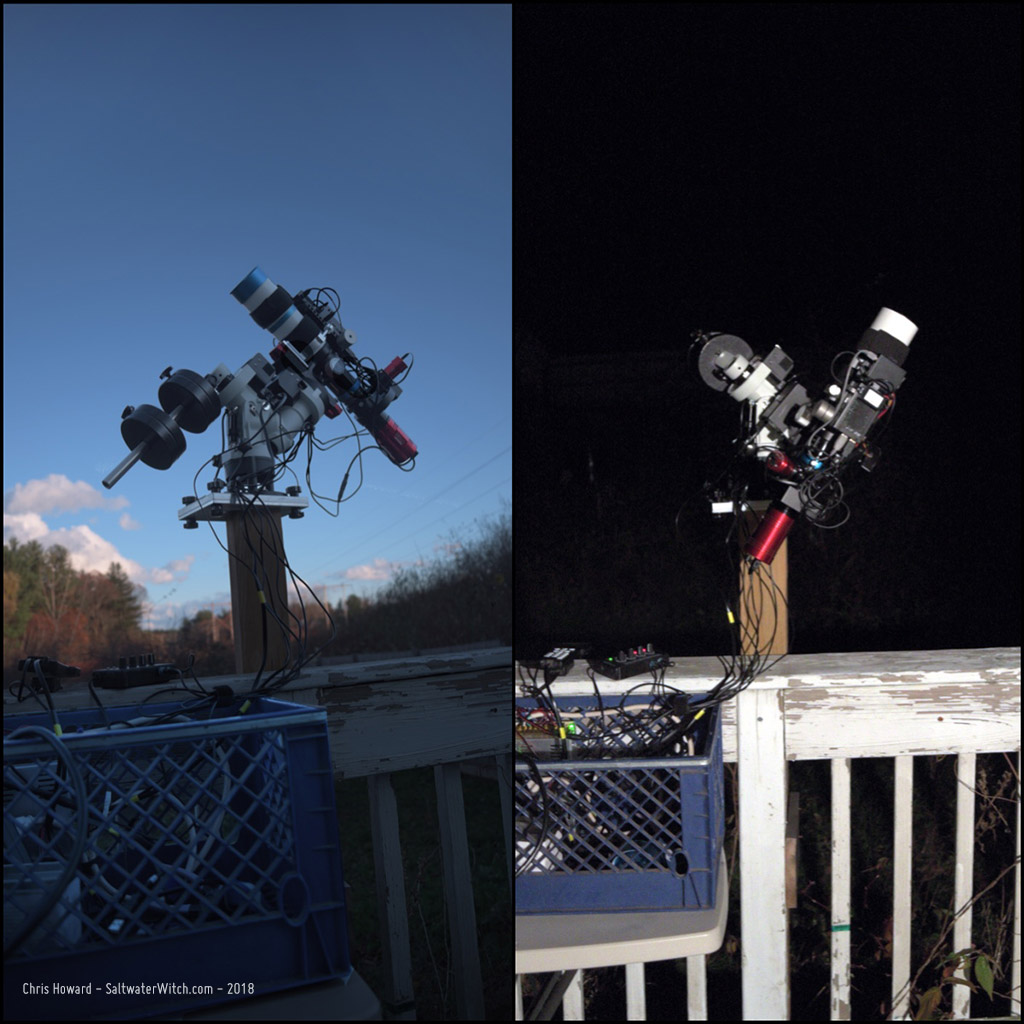
Here's a screenshot of Ekos and KStars running, with the guiding tab opened. It was pretty windy, so an RMS" of 0.58 is great, but overall my guiding has improved since going to an Off-Axis Guider. I'm now using the Orion Thin OAG on both trains--color and narrowband, and the difference is noticeable. It took some time to dial sensor and focus distances in, but results are clear, and I just don't think I'll ever go back to a guide scope.
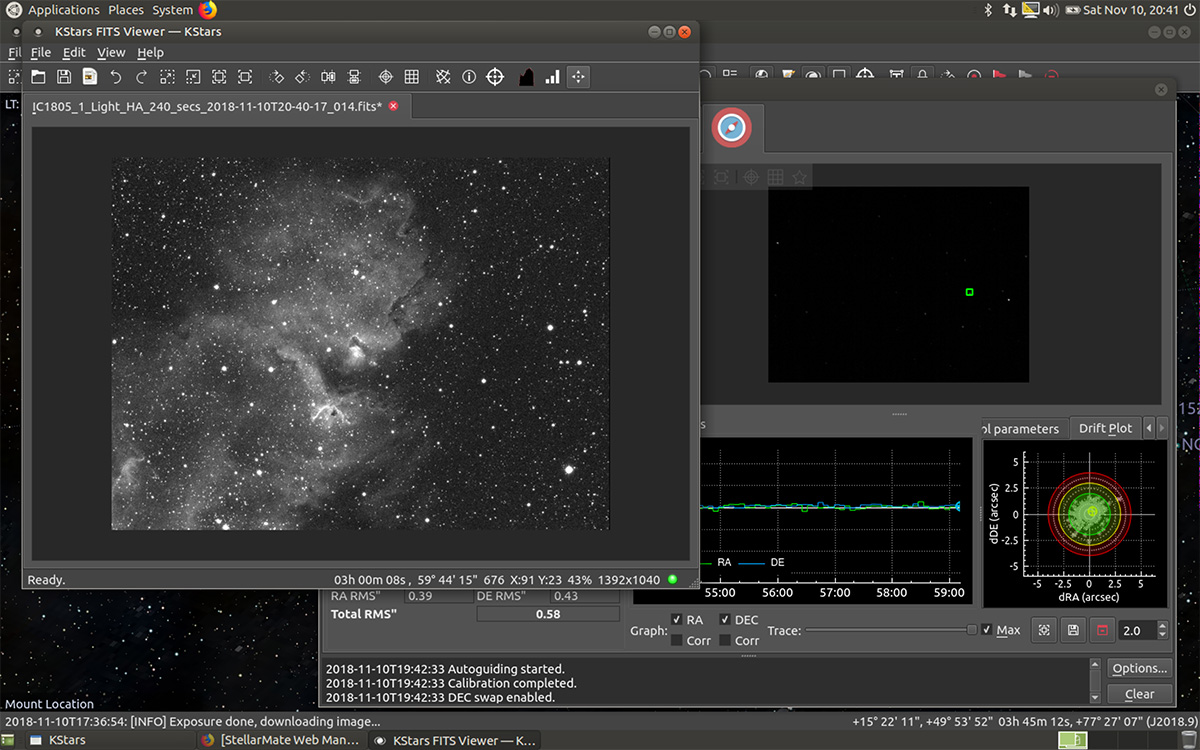
Posted November 11, 2018
Astro Session: October 30, 2018
I had several hours of clear skies, still relatively dark before the moon rose, and I set up the William Optics GT81 and ZWO ASI071MC color camera to take a bunch of subs of M33 and M45--Triangulum Galaxy and the Pleiades, two of my favorite targets this time of year--but this is my first time shooting these with the ZWO ASI071MC cooled color camera, and the resulting images show how amazing the ZWO is. (ZWO ASI071MC running at -10C, William Optics GT81 + WO Flat 6A II f/4.7, iOptron CEM25P EQ mount, Orion OAG + ZWO ASI120MM-S guide cam, Stellarmate OS (INDI/KStars/Ekos) running on Raspberry Pi 3b+).
The Pleiades, M45, also known as "The Seven Sisters" and in Japanese as Subaru (昴). It's one of the most identifiable objects in the night sky, but it's more than just a loose group of stars. Located in the constellation Taurus, the Pleiades is a nearby open star cluster mostly made up of a batch of relatively young B-type stars amid (or behind) a reflection nebula that appears to surround and fill the space between the stars with veil-like sheets and threads. (WilliamOptics GT81, ZWO ASI071MC: 60 x 60 second and 60 x 120 second exposures, unity gain).
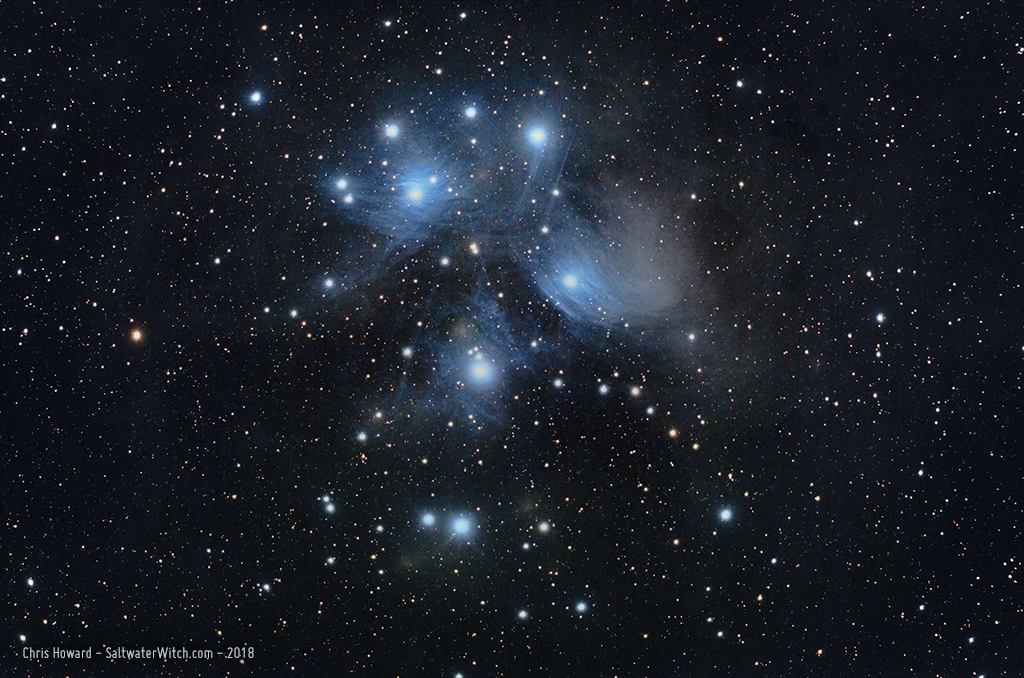
Triangulum Galaxy, M33, is a nearby spiral galaxy--around 3 million lightyears away, with as many as 40 billion stars. It's the third largest galaxy in our local group, and appears to be bound up in Andromeda's gravitational pull. It also contains some amazing nebulae and other deep space objects, e.g., NGC 604 is a massive H II region--that's the bright pinkish blob, the size of a large star, at the lower left side of the galactic spiral. Keep in mind that nearly every star-like point of light in this image is actually a star in the Milky Way, our own galaxy. (WilliamOptics GT81, ZWO ASI071MC: 90 x 60 second exposures, unity gain).
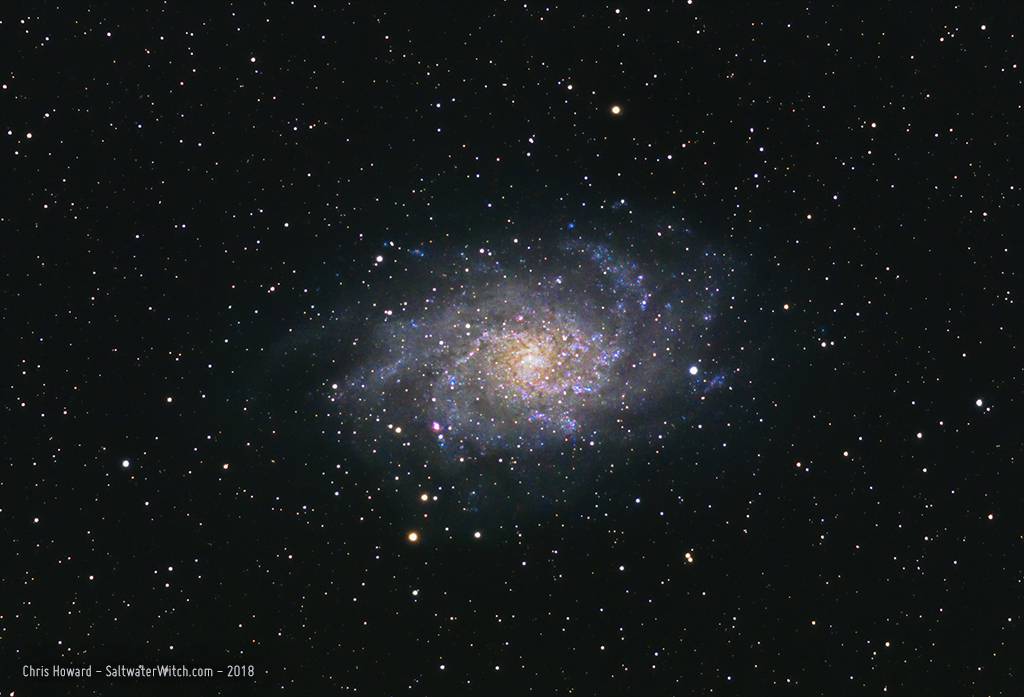
Posted October 30, 2018
Astro Session: July 9, 2018
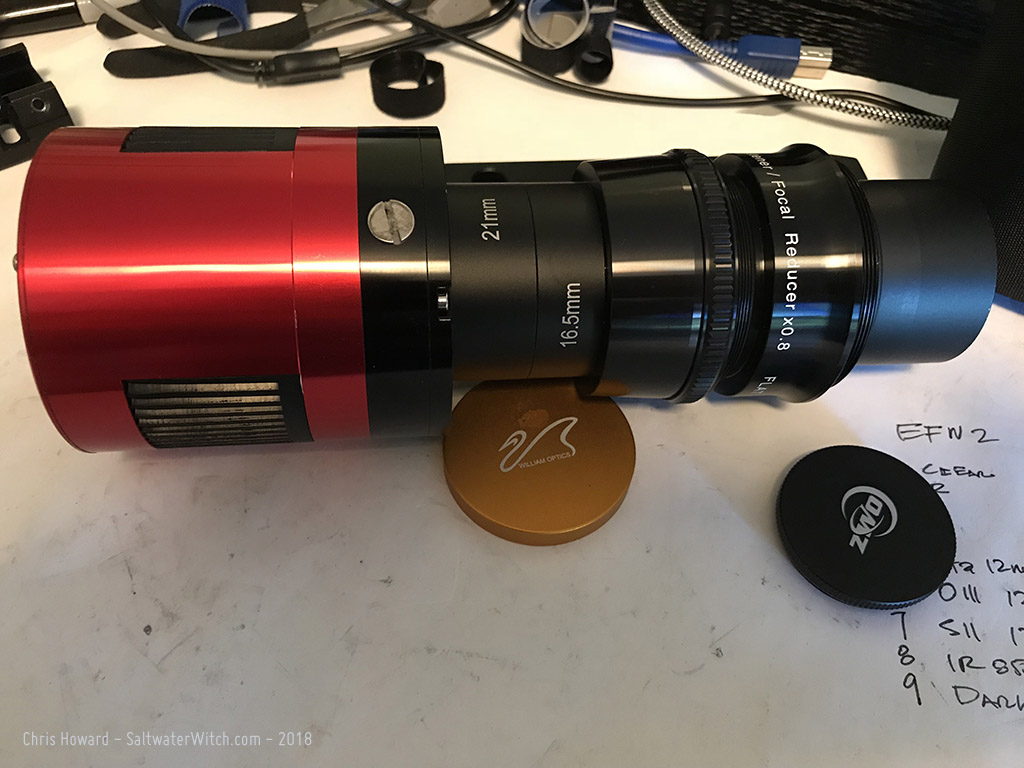 I recently bought the William Optics FLAT 6A II, and finally made it out under the stars to take some sub-exposures. I paired it with my GT-81 and ZWO ASI071MC color CMOS camera. The FLAT 6A II is a 0.8x reducer/field flattener; it's adjustable for different focal lengths, and so far, with my limited use, it appears to be quite a leap over the old William Optics F6-A I've used for a few years. The ASI071 has an APS-C sized sensor, and anyone with a large sensor astro camera or DSLR knows if you don't want field curvature with your refractor you need some sort of flattener. The FLAT6AII design makes it easy to dial in the correct distance for the scope you're using. The old reducer/flattener worked, but I had to test out a dozen different flattener to sensor distances, and still had to do some cropping and processing to fix the corners. This new FLAT 6AII provides a fairly flat field across the entire view. Equipment: William Optics GT-81 + FLAT 6A II 0.8x reducer f/4.7, ZWO ASI071MC-Cool color CMOS camera - gain 0 offset 8, ZWO ASI120MM-S Guide Cam + 130mm guide scope.
I recently bought the William Optics FLAT 6A II, and finally made it out under the stars to take some sub-exposures. I paired it with my GT-81 and ZWO ASI071MC color CMOS camera. The FLAT 6A II is a 0.8x reducer/field flattener; it's adjustable for different focal lengths, and so far, with my limited use, it appears to be quite a leap over the old William Optics F6-A I've used for a few years. The ASI071 has an APS-C sized sensor, and anyone with a large sensor astro camera or DSLR knows if you don't want field curvature with your refractor you need some sort of flattener. The FLAT6AII design makes it easy to dial in the correct distance for the scope you're using. The old reducer/flattener worked, but I had to test out a dozen different flattener to sensor distances, and still had to do some cropping and processing to fix the corners. This new FLAT 6AII provides a fairly flat field across the entire view. Equipment: William Optics GT-81 + FLAT 6A II 0.8x reducer f/4.7, ZWO ASI071MC-Cool color CMOS camera - gain 0 offset 8, ZWO ASI120MM-S Guide Cam + 130mm guide scope.
 Testing:
Testing:
With the GT81 and ASI071 I get a 3.54° x 2.35° field of view, and I can capture some big chunks of the night sky. Here are three from the last two nights: [1] the Pelican Nebula (IC 5070) and the edge of the North America Nebula (NGC7000) at the bottom, [2] IC 1396 nebula with the Elephant's Trunk at the top and the Garnet Star bottom left, and [3] M31, our galactic neighbor, the Andromeda Galaxy.
Pelican Nebula image info: ZWOASI071MC 39 x 240 second color subs stacked in DSS, processed in PSCC2018
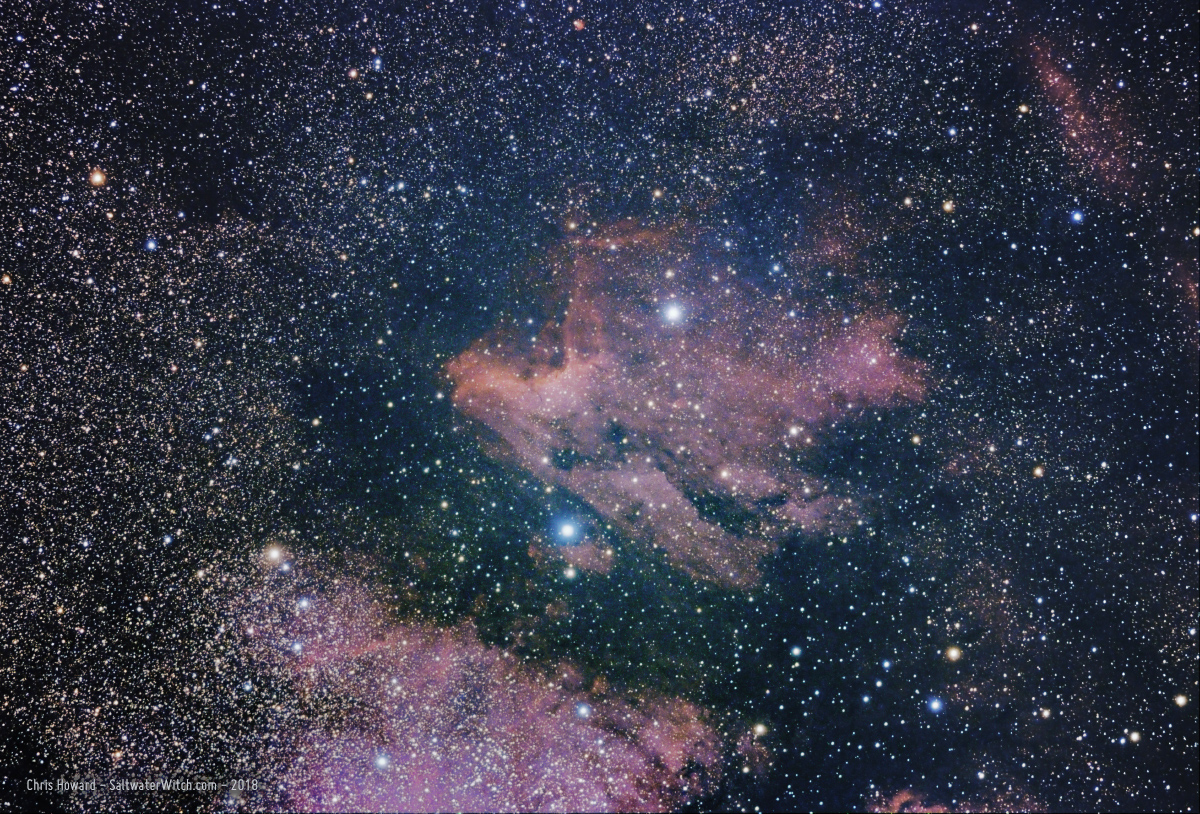
IC 1396 region image info: ZWOASI071MC 21 x 300 second color subs stacked in DSS, processed in PSCC2018
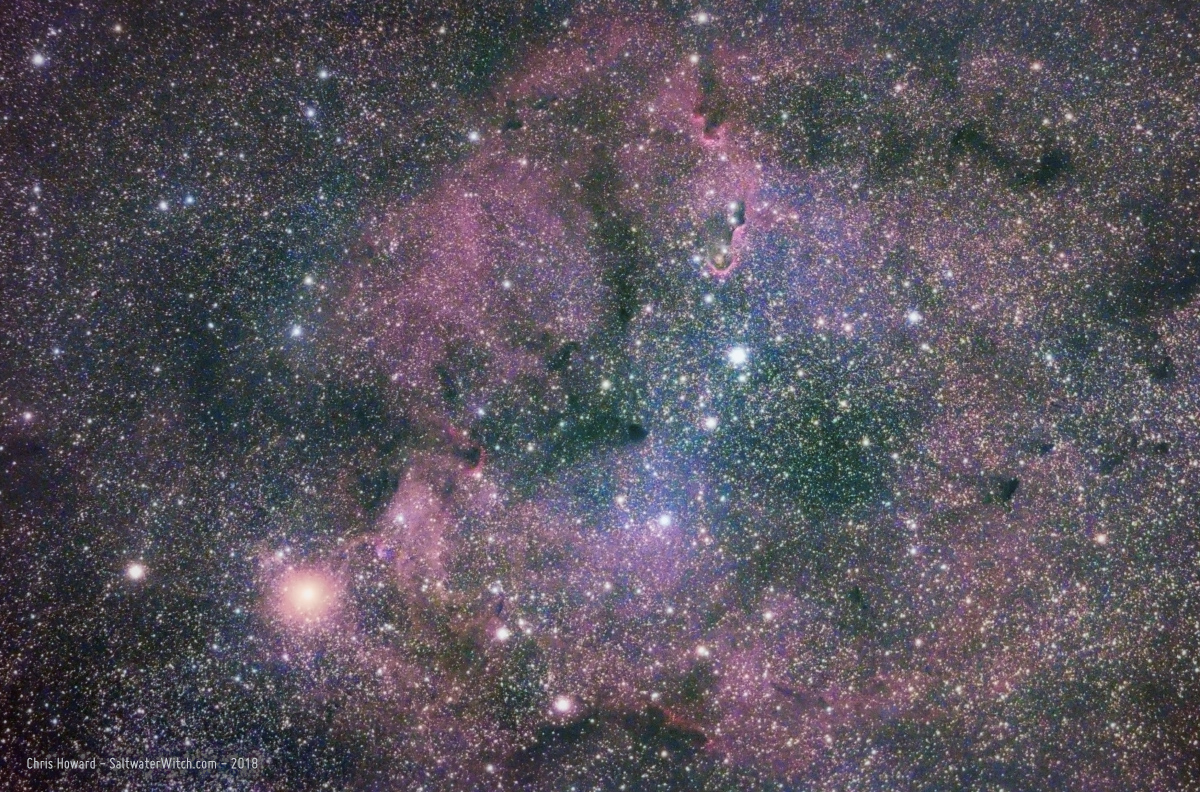
The Andromeda Galaxy. The last time I photographed Andromeda (M31) was 2015, maybe fall of 2014? It's been a while. I was using a DSLR--that was the only camera I had, and I had it on a terribly-used Celestron CG-5 equatorial mount with some aftermarket RA/DEC motors. By "terribly-used" I mean you could drive a truck through the gear backlash. Even so, I still managed to get some decent 30-second exposures of Andromeda, Orion Nebula, and other big bright targets in the sky. Well, I'm back with our galactic neighbor, and with much better gear: 192 x 120-second sub-exposures stacked in DSS, processed in PSCC2018, ZWO ASI071MC camera at -10C, William Optics GT81 APO, iOptron CEM25P EQ mount.
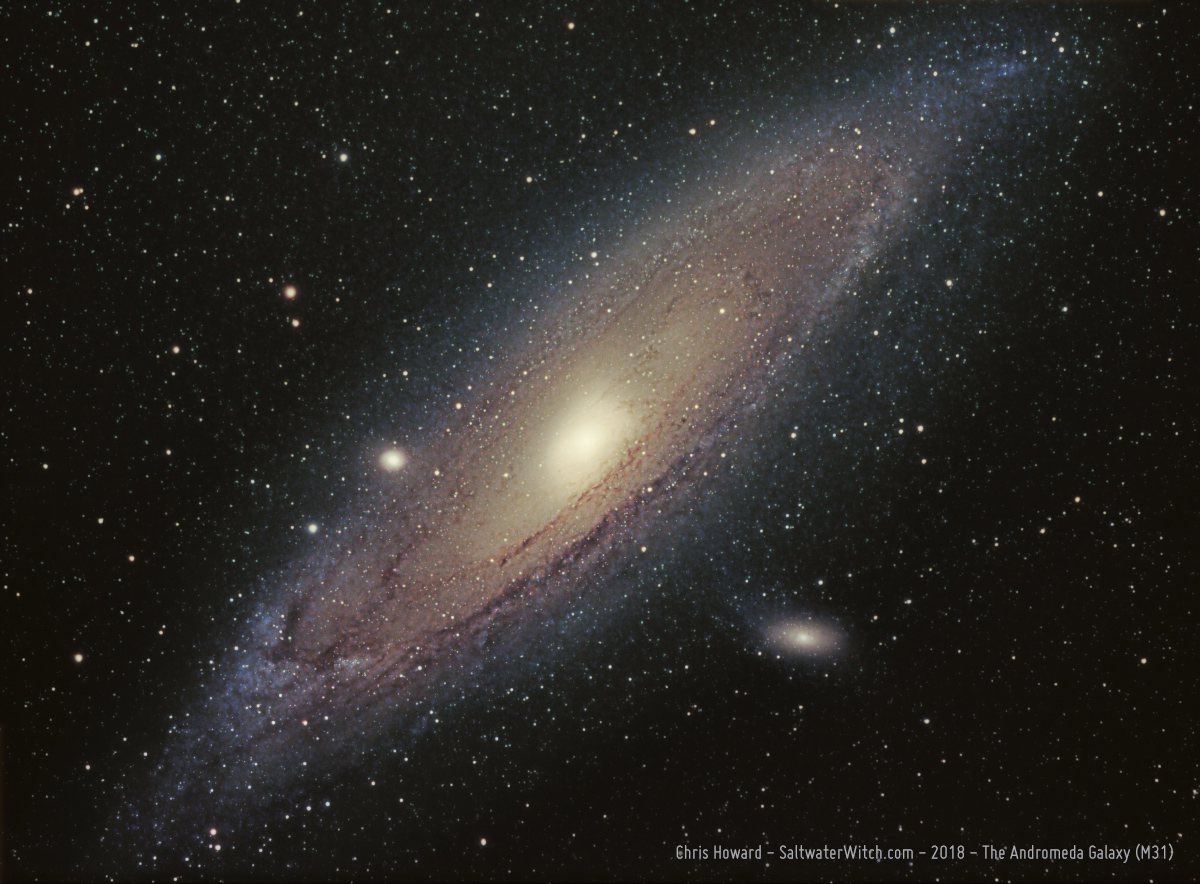
Posted July 9, 2018
Astro Session: June 30, 2018
The Eagle Nebula (Messier 16, NGC 6611, Star Queen Nebula) is an open star cluster and emission nebula in the constellation Serpens, about 7000 lightyears away from us. Imaging Info: 96 x 240 sec. Ha + 42 x 240 sec. OIII frames stacked in DSS, processed in PSCC2018. These frames were taken over several nights. You can see the numbers are a bit unbalanced, but the clouds moved in during the OIII sequence last night, and there was nothing I could do. I went ahead and stacked and processed them as they are. I'll probably come back to this one in the future with more oxygen-3 (and maybe sulphur-2) to achieve something like the actual proportional levels of light from the nebula across these bandpasses. Equipment: William Optics ZS61, Atik 414EX mono CCD, 12nm Astronomik Ha filter, 12nm Astronomik OIII filter, CEM25P EQ Mount, ZWO ASI120MM-S Guide Cam + Orion TOAG, INDI/KStars/Ekos control software. Location: Stratham, New Hampshire, Bortle: 4, SQM: 20.62 https://www.astrobin.com/353803

Posted June 30, 2018
Astro Session: June 16, 2018
It was narrowband time last night in the backyard. I took a couple hours of hydrogen-alpha (Ha) sub-exposures of M17, the Swan Nebula in the constellation Sagittarius. M17 is about 5,500 light-years away. It's also called the Omega Nebula, Checkmark Nebula, and sometimes the Horseshoe Nebula, but all I see is a swan--with a black beak, neck arched forward, and wings outstretched. The bright region in the middle is the swan's chest. I started to take a few OIII frames on the 16th, but by that time M17 was heading back toward the southern horizon, and so I jumped over to the "Cygnus Wall" in NGC 7000 (North America Nebula). I captured several hours of OIII data there, amazing stuff, and I've already posted the finished image in Ha and OIII. I came back to M17 on the 21st, and took another 40 x 300 second subs in OIII. (M17 info: Ha 16 x 300 second + 82 x 120 second exposures + 20 dark frames, OIII 40 x 300 second exposures + 20 dark frames, stacked in DSS, William Optics ZS61, Atik 414EX mono CCD, 7nm Optolong 2" Ha filter, 8.5nm Baader 2" OIII filter, CEM25P EQ Mount, QHY5III178 guide cam with the Orion TOAG, https://www.astrobin.com/352947).
UPDATE: The Swan Nebula (M17) bi-color narrowband with the WilliamOptics ZS61 and the Atik 414EX. I shot the hydrogen-alpha frames on June 16th (16 x 300 second exposures + 82 x 120 second exposures) and I came back on the 21st to shoot 40 x 300 second exposures in oxygen-3. I decided not to shoot sulphur-2 frames based on the wonderful result with bi-color for my Cygnus Wall image set (6.8 hours of Ha + OIII). For the Swan Nebula (this post) and Cygnus Wall (last post) images I used the Hydrogen-alpha/Oxygen-3 bi-color process developed in an article by Travis Rector, et. al. in The Astronomical Journal here: https://doi.org/10.1086/510117, and detailed here: https://www.starrywonders.com/bicolortechniquenew.html

Posted June 16, 2018
Astro Session: June 8, 2018
 How about a little Voldemort with your Astronomy? Here's Barnard 104, the Fish Hook Nebula (backward checkmark nebula was already taken?), just left of the star beta Scuti in the constellation Scutum--along with several other absorption nebulae in the Barnard Catalogue, 113, 111, 110, 107, and B106. (See the image below). These are the dark cloudy regions across the middle, which stand out against the glow of a billion stars in this area of the Milky Way Galaxy. (Okay, I'm being a bit deceptive with the drama there. It's probably more like 5 or 10 billion). Oh, and let's not forget NGC 6704, the open star cluster toward the bottom in the center. A note on the "Barnard Catalogue", which is what I've always called it: I just found out the official name for it is the very Harry Potter sounding, Barnard Catalogue of Dark Markings in the Sky. Go home, Death Eaters! The star gazing geeks got here first! (ZWO ASI071MC cooled CMOS camera at -10°C, iOptron CEM25P EQ mount, William Optics ZenithStar 61 f/5.9, 12 x 120 sec. sub exposures, stacked in DSS. Location: Stratham, New Hampshire, US. Bortle 4).
How about a little Voldemort with your Astronomy? Here's Barnard 104, the Fish Hook Nebula (backward checkmark nebula was already taken?), just left of the star beta Scuti in the constellation Scutum--along with several other absorption nebulae in the Barnard Catalogue, 113, 111, 110, 107, and B106. (See the image below). These are the dark cloudy regions across the middle, which stand out against the glow of a billion stars in this area of the Milky Way Galaxy. (Okay, I'm being a bit deceptive with the drama there. It's probably more like 5 or 10 billion). Oh, and let's not forget NGC 6704, the open star cluster toward the bottom in the center. A note on the "Barnard Catalogue", which is what I've always called it: I just found out the official name for it is the very Harry Potter sounding, Barnard Catalogue of Dark Markings in the Sky. Go home, Death Eaters! The star gazing geeks got here first! (ZWO ASI071MC cooled CMOS camera at -10°C, iOptron CEM25P EQ mount, William Optics ZenithStar 61 f/5.9, 12 x 120 sec. sub exposures, stacked in DSS. Location: Stratham, New Hampshire, US. Bortle 4).

So, all in all, a successful night of astronomy stuff, even with the clouds rolling in around 2 am. Here are a couple more wide-field shots from the session, the Eagle Nebula and the Sadr Region--the diffuse nebula (IC 1318) around gamma Cygni, also called Sadr (center star in the constellation Cygnus).


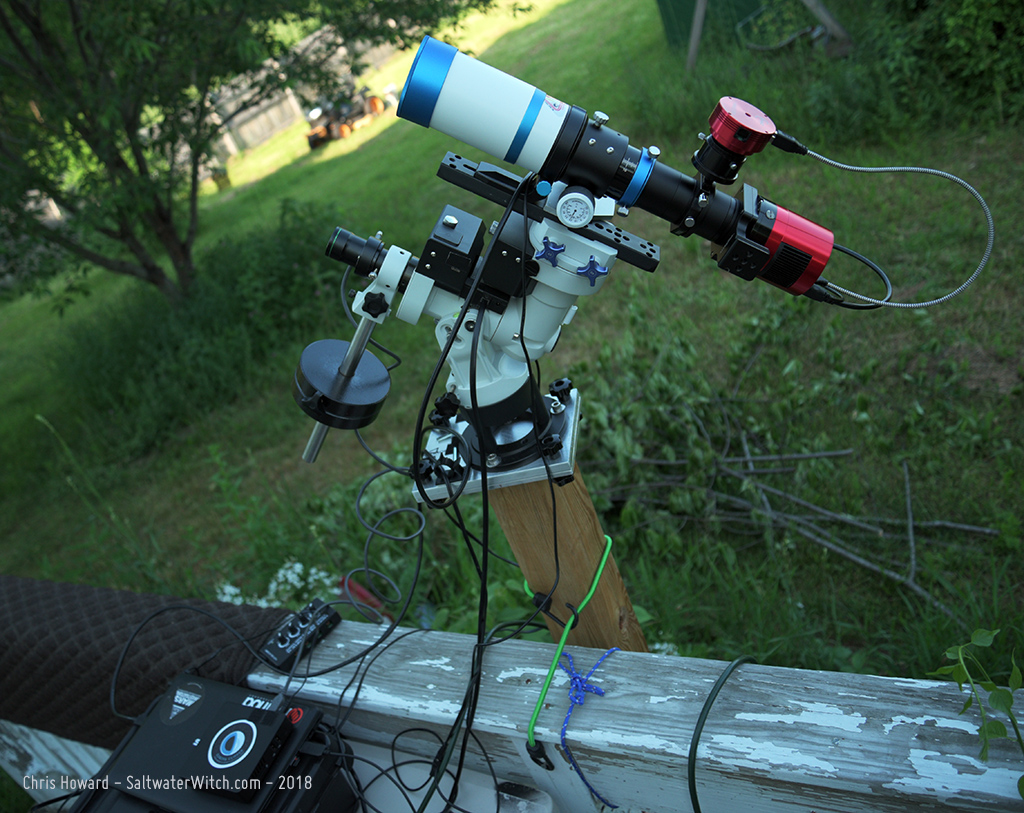 I spent a few hours last night dialing in the Orion "TOAG" or Thin Off-Axis Guider, which I bought a couple years ago, but have never been able to get working properly. I've tried seven or eight times, added it to my imaging train a couple times a year, attempting to get things working without success. Well, I went at it again last night, and you know what? It came together. I still have some weirdness to tinker with--to work out, but for the first time I wasn't guiding with a separate scope. I was guiding at the same focal length as the ZS61 using a pick-off prism that directs a portion of the field of view up into the guide camera. Here's the setup I used last night to dial-in the distance between the primary camera and guide camera, and then bring everything into focus. I ended up with some pretty cool shots, but my main purpose was to get Off-Axis Guiding (OAG) adjusted and working--and that was with me slewing around the sky to clear areas between banks of clouds to find some halfway interesting targets. In this setup I'm using my trusty ZWO ASI120MM-S for guiding, and the ZWO ASI071MC cooled color camera for the primary. The goal here is to be able to guide (track the motion of the earth against the star field to a very fine degree, and make small incremental adjustments to the EQ mount) so that I can take long exposures without worrying about the external guidescope issues I know all of you care deeply about, like field rotation and differential motion between a guide scope and imaging telescope. I have been able to take 20 minute exposures with a guidescope and camera, but the stars are not as sharp as I would like--think pressing down the button of your camera and holding the shutter open for 20 or 30 minutes and have everything in the field of view remain in sharp focus. That's essentially what the guiding system accomplishes, taking continuous images of the stars and feeding them to some pretty sophisticated software that controls the motion of the equatorial mount (that's the white z-shaped device with the black boxes on which the telescope is fastened and balanced).
I spent a few hours last night dialing in the Orion "TOAG" or Thin Off-Axis Guider, which I bought a couple years ago, but have never been able to get working properly. I've tried seven or eight times, added it to my imaging train a couple times a year, attempting to get things working without success. Well, I went at it again last night, and you know what? It came together. I still have some weirdness to tinker with--to work out, but for the first time I wasn't guiding with a separate scope. I was guiding at the same focal length as the ZS61 using a pick-off prism that directs a portion of the field of view up into the guide camera. Here's the setup I used last night to dial-in the distance between the primary camera and guide camera, and then bring everything into focus. I ended up with some pretty cool shots, but my main purpose was to get Off-Axis Guiding (OAG) adjusted and working--and that was with me slewing around the sky to clear areas between banks of clouds to find some halfway interesting targets. In this setup I'm using my trusty ZWO ASI120MM-S for guiding, and the ZWO ASI071MC cooled color camera for the primary. The goal here is to be able to guide (track the motion of the earth against the star field to a very fine degree, and make small incremental adjustments to the EQ mount) so that I can take long exposures without worrying about the external guidescope issues I know all of you care deeply about, like field rotation and differential motion between a guide scope and imaging telescope. I have been able to take 20 minute exposures with a guidescope and camera, but the stars are not as sharp as I would like--think pressing down the button of your camera and holding the shutter open for 20 or 30 minutes and have everything in the field of view remain in sharp focus. That's essentially what the guiding system accomplishes, taking continuous images of the stars and feeding them to some pretty sophisticated software that controls the motion of the equatorial mount (that's the white z-shaped device with the black boxes on which the telescope is fastened and balanced).
Posted June 8, 2018
Astro Session - May 24, 2018
Fourteen stacked frames through the powerlines: The Lagoon Nebula (M8, NGC 6523) and Trifid Nebula (M20, NGC 6514). We have a couple sets of transmission lines running east-west south of our property, and unfortunately they interfere with the amazing stuff in the constellation Sagittarius, which is even lower on the horizon than Serpens (also amazing). Transit for M8 is 23°, compared with 33° or so for the Eagle Nebula. We really need to take a trip south to get a better view of these beautiful ionized hydrogen structures. At the middle and lower left I also captured two globular clusters, NGC 6544 and NGC 6553. That's a very bright section of the milky way lighting up the whole lower left of the frame. Yes, there are stars running through the long bands of power lines, because over the 16 or so minutes of exposure time the earth rotated about four degrees. So, those stars were not obscured by the lines in some of my exposures, but when I stack them all together, aligning all the stars, they're going to appear where they were when camera caught them. That's also why the powerlines appear blurry--they're actually smeared out across the frame. They are much narrower and sharper than that in the individual subs. What's funny--to me, anyway--is that I was shooting the Eagle Nebula, and after 30 or so exposures I started to wonder if I had a chance to get the Lagoon Nebula. I slewed even lower toward the horizon, took a test frame, and saw the powerlines running through it...and thought what the hell, maybe the lines will look kind of cool in the foreground.
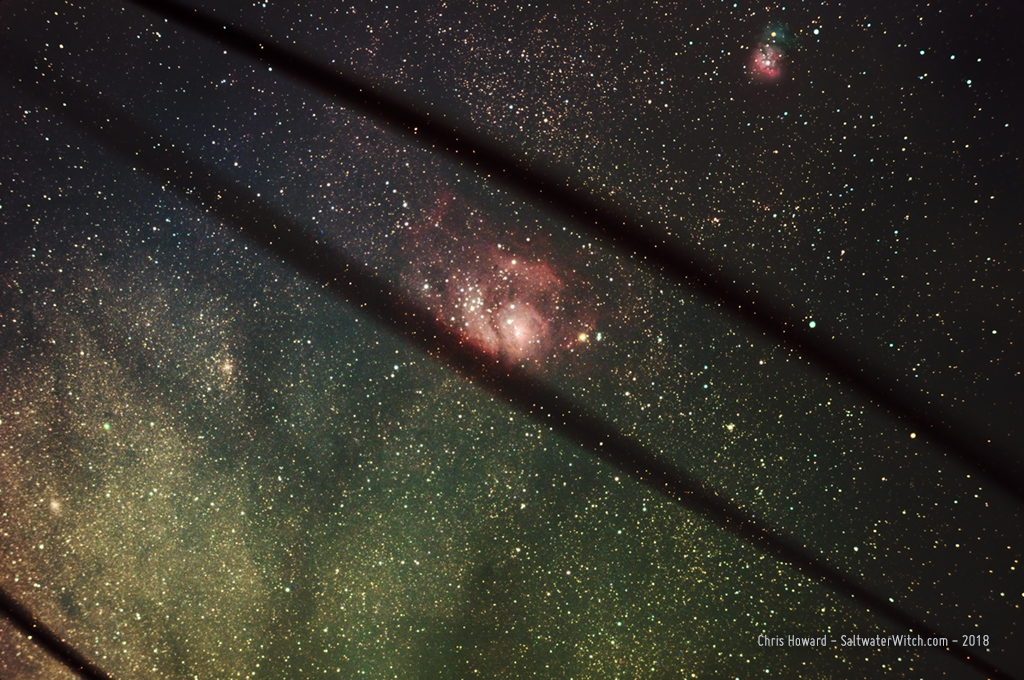
North America Nebula (NGC 7000) 50 stacked frames from the ZWO071MC camera.
The Eagle Nebula, Messier 16, sometimes called Star Queen is a diffuse nebula in the constellation Serpens. M16 was only 22° above the horizon to the southeast when I was taking these subs, low enough to have the atmosphere and some light pollution from Hampton affect the result. Even so, I'm here in New Hampshire at 43° latitude, and I'll take any chance I can get to shoot the Eagle Nebula.
Swan Nebula (M17, Checkmark Nebula, Omega Nebula, NGC 6618) is another H II region in the constellation Sagittarius.
The Great (and powerful) Globular Cluster in the constellation Hercules (M13) with a hint of the spiral galaxy NGC 6207 at the top. Last night was my first night out with the William Optics ZenithStar 61, and as I expected, it's just a brilliant little refractor. Paired with the ZWO ASI071MC cooled camera and the WO 0.8x Flat/Reducer F6-A, you get a spectacular 4.7° × 3.1° field of view--that's a big chunk of the sky. If you're looking for a pretty fast widefield apochromatic, this is it. It's not the best choice for the Hercules cluster, but I was just slewing all over the sky, taking pictures, and waiting for the North America Nebula to get above 30 degrees.

Posted May 24, 2018
Astro Session - April 22, 2018
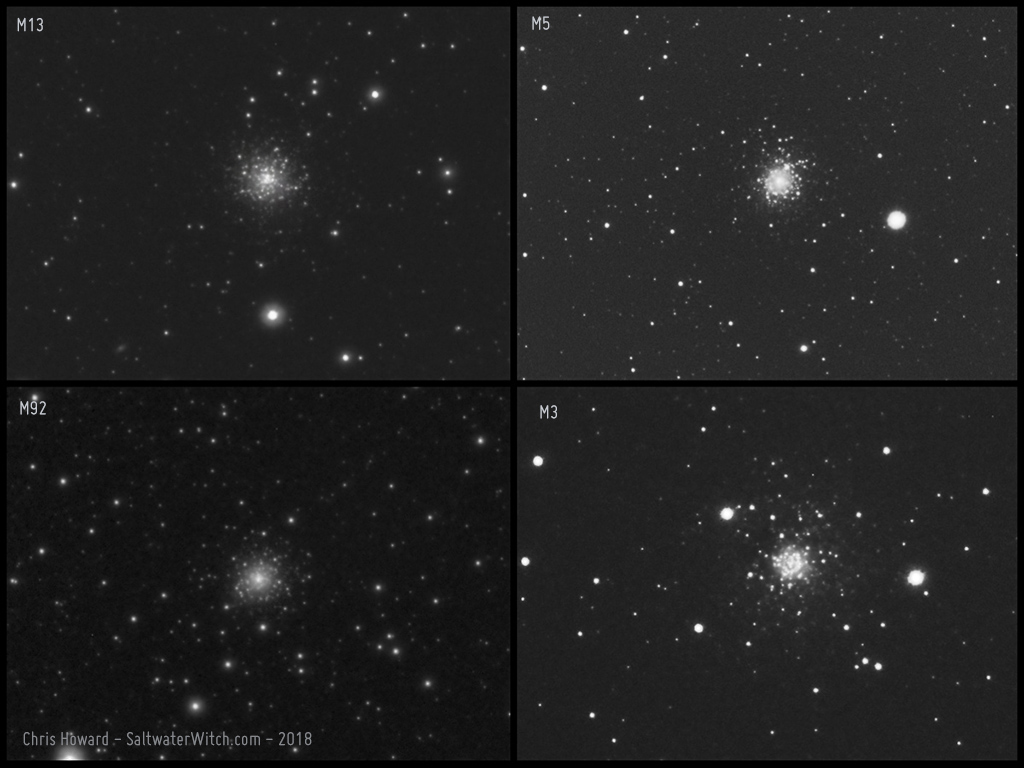 Although the skies were clear last night, the "seeing" wasn't great--"seeing" refers to the amount of atmospheric interference from temperature changes, convection currents, and other funny stuff going on in the air above your telescope. I did get to test out the Pentax 200mm f/4 lens with the Atik 414EX monochrome CCD, and an Ha longpass filter. These clusters are fairly small, so this isn't a very good setup for shooting them, but here you go anyway. Top left: the 300,000 stars that make up Messier 13 (NGC 6205), a globular cluster in the constellation Hercules. Messier 5 in the constellation Serpens. The M3 globular cluster the constellation Canes Venatici. Messier 92 (NGC 6341) is another cluster in the constellation Hercules.
Although the skies were clear last night, the "seeing" wasn't great--"seeing" refers to the amount of atmospheric interference from temperature changes, convection currents, and other funny stuff going on in the air above your telescope. I did get to test out the Pentax 200mm f/4 lens with the Atik 414EX monochrome CCD, and an Ha longpass filter. These clusters are fairly small, so this isn't a very good setup for shooting them, but here you go anyway. Top left: the 300,000 stars that make up Messier 13 (NGC 6205), a globular cluster in the constellation Hercules. Messier 5 in the constellation Serpens. The M3 globular cluster the constellation Canes Venatici. Messier 92 (NGC 6341) is another cluster in the constellation Hercules.
